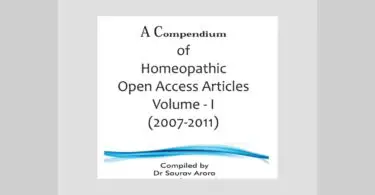The total volume of clinical research in homeopathy is minuscule compared with that in conventional medicine; it attracts polarised interpretation by homeopathy’s advocates and detractors. The aim of this brief article is to clarify some essential facts and to recommend a number of avenues of future research development.
Summary of the clinical research evidence
There is a distinct body of research supporting the view that homeopathy can have effects greater than placebo, or be at least as effective as a standard treatment. In peer-reviewed journal papers published to the end of 2008, findings in 60 (43.5%) of 138 randomised controlled trials (RCTs) have been positive.[1] Most of the remaining peer-reviewed literature has reported statistically non-significant (and therefore usually non-conclusive) results; few papers have reported clearly negative findings.
Consistent with the small number of clinical trials in total, the evidence for or against homeopathy in most medical conditions is fragmentary. However, there is a majority of replicated RCT evidence, with support in most cases from systematic reviews, that classical (individualised) homeopathy has statistically significant effects in childhood diarrhoea[2] and fibromyalgia,[3], [4], [5] and that specific medicines (standardised homeopathic treatment) can have statistically significant effects in influenza,[6] seasonal allergic rhinitis,[7], [8] sinusitis[9], [10], [11] and vertigo.[12] In many cases, the body of evidence in a given medical condition has been the work of a single research group (childhood diarrhoea, J Jacobs; seasonal allergic rhinitis, D Reilly) or is based on one specific homeopathic medicine (influenza, Oscillococcinum®; seasonal allergic rhinitis, Galphimia glauca; vertigo,Vertigoheel®). Corroboration of positive findings by independent research groups is crucial.
Raising standards of research
All new RCTs need to focus additionally on the clinical importance of the observed effects, rather than merely their statistical significance. This distinction between effect size and statistical significance has been insufficiently addressed in the past and requires a great deal more emphasis.[13]
Much of the clinical research in homeopathy to date has adopted the RCT approach with placebo control. It should be recalled that this study design normally has particular reference to a very highly defined clinical intervention and patient sample. Research of this nature is vital to demonstrate convincingly that a specified homeopathic medicine may have efficacy in a specified set of patients; this approach (termed an explanatory trial) comprises the majority of the current RCT literature in homeopathy. More consideration is required as to whether placebo design is compatible with investigating whole system effects of homeopathic treatment (as in individualised homeopathy).[14], [15], [16]
Pragmatic study design (investigation of treatment in everyday practice) enables generalisation of trial findings to a wider population of patients.[17] It is arguably more appropriate than an explanatory trial for studying whole system effects of a highly individualised treatment. There are very few pragmatic trials in the current research literature of classical homeopathy.
Each RCT approach (explanatory and pragmatic) should be pursued, as appropriate, within a research strategy in homeopathy. Clinical research of non-randomised design also contributes importantly to a developing evidence base and provides a secure foundation to inform additional investigation.[18], [19]
Developing an agenda for research in homeopathy
To date, the clinical areas in which most research in homeopathy has been conducted, do not match well with those for which it is most often used in practice. Homeopathy is most frequently used for dermatological, ear nose & throat, gastrointestinal or gynaecological problems, where there may be little or no specific RCT evidence. Some of those areas might be classified as ‘effectiveness gaps’ (where available conventional treatments are not fully effective)[20] and include, more specifically, eczema, otitis media, irritable bowel syndrome, menopausal symptoms, and premenstrual syndrome. Moreover, patients with complex medical predicaments are not normally eligible for RCT research, and they should be included in suitable non-randomised studies.[21]
Economic evaluation is of clear importance in the future development of research in homeopathy, and should be accommodated in new RCTs for areas where positive evidence of effectiveness became clearly corroborated. A recent trial of the homeopathic medicine Sinfrontal® for acute sinusitis characterises this approach.[22]
References
[1] Faculty of Homeopathy. Consulted 10th November 2009.
[2] Jacobs J, Jonas WB, Jimenez-Perez M, Crothers D (2003). Homeopathy for childhood diarrhea: combined results and metaanalysis from three randomized, controlled clinical trials. Pediatric Infectious Disease Journal, 22: 229-234.
[3] Fisher P (1986). An experimental double-blind clinical trial method in homoeopathy. Use of a limited range of remedies to treat fibrositis. British Homeopathic Journal, 75: 142-147.
[4] Bell IR, Lewis DA 2nd, Brooks AJ, et al (2004). Improved clinical status in fibromyalgia patients treated with individualized homeopathic remedies versus placebo. Rheumatology, 43: 577-582.
[5] Relton C, Smith C, Raw J, et al (2009). Healthcare provided by a homeopath as an adjunct to usual care for fibromyalgia (FMS): results of a pilot randomised controlled trial. Homeopathy, 98: 77-82.
[6] Vickers A, Smith C (2006). Homoeopathic Oscillococcinum for preventing and treating influenza and influenza-like syndromes (Cochrane review). In: The Cochrane Library. Chichester, UK: John Wiley & Sons, Ltd. CD001957.
[7] Wiesenauer M, Lüdtke R (1996). A meta-analysis of the homeopathic treatment of pollinosis with Galphimia glauca. Forschende Komplementärmedizin und Klassische Naturheilkunde, 3: 230-236.
[8] Taylor MA, Reilly D, Llewellyn-Jones RH, et al (2000). Randomised controlled trials of homoeopathy versus placebo in perennial allergic rhinitis with overview of four trial series. British Medical Journal, 321: 471-476.
[9] Weiser M, Clasen B (1994). [Randomized, placebo-controlled, double-blind study of the clinical efficacy of the homeopathic Euphorbium compositum-S nasal spray in cases of chronic sinusitis]. Forschende Komplementärmedizin, 1: 251-259.
[10] Friese K-H, Zabalotnyi DI (2007). [Homeopathy in acute rhinosinusitis. A double-blind, placebo controlled study shows the efficiency and tolerability of a homeopathic combination remedy]. HNO, 55: 271-277.
[11] Zabolotnyi DI, Kneis KC, Richardson A, et al (2007). Efficacy of a complex homeopathic medication (Sinfrontal) in patients with acute maxillary sinusitis: a prospective, randomized, double-blind, placebo-controlled, multicenter clinical trial. Explore (NY), 3: 98-109.
[12] Schneider B, Klein P, Weiser M (2005). Treatment of vertigo with a homeopathic complex remedy compared with usual treatments: a meta-analysis of clinical trials. Arzneimittelforschung, 55: 23-29.
[13] Mathie RT (2003). The research evidence base for homeopathy: a fresh assessment of the literature. Homeopathy, 92: 84-91.
[14] Mason S, Tovey P, Long AF (2002). Evaluating complementary medicine: methodological challenges of randomised controlled trials. British Medical Journal, 325: 832-834.
[15] Verhoef MJ, Lewith G, Ritenbaugh C, et al (2005). Complementary and alternative medicine whole systems research: beyond identification of inadequacies of the RCT. Complementary Therapies in Medicine, 13: 206-212.
[16] Bell IR, Koithan M (2006). Models for the study of whole systems. Integrative Cancer Therapies, 5: 293-307.
[17] MacPherson H (2004). Pragmatic clinical trials. Complementary Therapies in Medicine, 12: 136-140.
[18] White A, Ernst E (2001). The case for uncontrolled clinical trials: a starting point for the evidence base for CAM. Complementary Therapies in Medicine, 9: 111-115.
[19] Walach H, Jonas WB, Lewith GT (2002). The role of outcomes research in evaluating complementary and alternative medicine. Alternative Therapies in Health and Medicine, 8: 88-95.
[20] Fisher P, van Haselen R, Hardy K, et al (2004). Effectiveness gaps: A new concept for evaluating health service and research needs applied to complementary and alternative medicine. Journal of Alternative and Complementary Medicine, 10: 627-632.
[21] Thompson EA, Mathie RT, Baitson ES, et al (2008). Towards standard setting for patient-reported outcomes in the NHS homeopathic hospitals. Homeopathy, 97: 114-121.
[22] Kneis KC, Gandjour A (2009). Economic evaluation of Sinfrontal® in the treatment of acute maxillary sinusitis in adults. Applied Health Economics and Health Policy, 7: 181-191.





Dear Sir,
Since in Homeopathic treatment, every individual is treated by constitutional remedy . Since each patient is different from one before and after even though remedy which gets result is same. Application of principle of Randomised Control Trial (RCT) is difficult to apply in research in Homeopathy At the most patients with different constitutions getting response to same remedy with different potencies can be studied. Hence for evidence based studies either energy level need to be studied
Dr.N.V.Pai